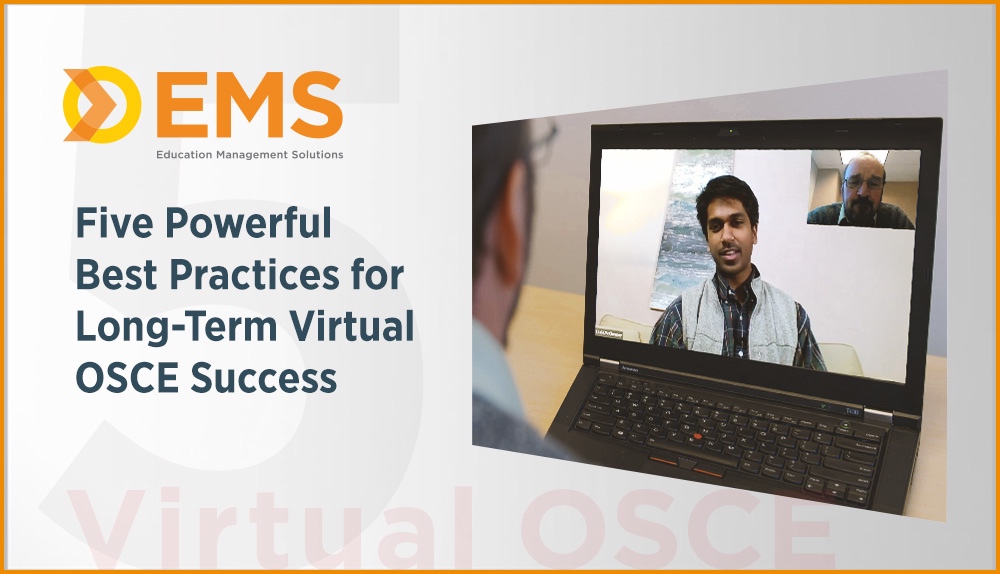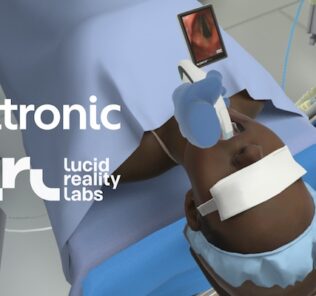5 Clinical Simulation Best Practices for Long-Term Virtual OSCE Success
While the COVID-19 pandemic may have changed demand for in-person learning, Education Management Solutions’ (EMS) commitment to providing quality educational experiences has not shifted. Through development of the SIMULATIONiQ Virtual OSCE solution, the company has been able to provide virtual healthcare simulation management technology to help clients and continue to deliver their best-in-class virtual, video-based curricula. This instruction includes observations, accrual of requisite clinical examination hours, boards and high-stakes exams such as the Objective Structured Clinical Examination (OSCE). Along with these benefits, when combined with clinical simulation best practices, simulation educators can set themselves up for long-term virtual OSCE success.
Virtual OSCE technologies allow healthcare simulation educators to deliver clinical decision-making training, a core requirement for effective post-graduate Residency clinical practices. They also make the ability to run an OSCE session from any location possible while providing a clear, consistent workflow for even the most technologically inexperienced participants. Further, they enhance retention by empowering learners to repeatedly view tutorials, clinical simulations and recorded sessions.
Being able to leverage instructors, staff and standardized patients (SPs) across multiple locations can help to maximize a return on investment (ROI) and overall flexibility as well. To ensure that these benefits and sustainable long-term successes are achieved during the adoption of virtual OSCE training, EMS recommends implementing the following five best practices.
Sponsored Content:
1. Integrated Teleconferencing: Simulation educators can facilitate live-learner and SP interaction via video-teleconferencing. They may also record sessions for debriefing with seamless, built-in integration. Virtual simulation management technology empowers simulation educators to schedule remote, video-based sessions between learners and SPs, conduct remote training, debrief, review clinical decision making with learners and more.
2. Advanced Reporting: Best practice reporting can help assure the long-term success of a simulation educator’s training initiatives. Their virtual OSCE platform makes being able to report on the complete spectrum of their educational programs possible, providing checklists and student performance assessments. They can then export the reports to a preferred format for detailed analysis.
3. Enhanced Workflows: Simulation educators can optimize their remote training and pre- and post-session workflows via an intuitive, multi-device user interface. The virtual OSCE solution makes learning to schedule sessions and teleconference meetings in advance easy. They can also use the virtual OSCE to conduct live or recorded session reviews. Plus, the technology automatically gives learners and SPs the resources they need to succeed with role-based access to requisite materials. Further, simulation educators who need to add a paging announcement can pre-record their message to automatically play through the browsers of learners or SPs.
Sponsored Content:
4. Adaptive Scheduling: The virtual OSCE platform also simplifies scheduling standalone or multi-encounter sessions in advance – or on the fly with real-time session creation. Virtual sessions can be created at any time, from any location or connected device and learner and SP encounters are captured within one contiguous video asset. The encounters are then available via playback for easy reviewing and secure sharing.
5. Powerful Security: Security matters! Passwords are required for all virtual encounters, giving you confidence that the full scope of your virtual clinical training delivery – including live OSCEs, debriefings, exports, archives and student and SP data – is protected by advanced encryption. Plus, you may securely observe and provide quality control for the entire educational experience across multiple locations via an intuitive virtual OSCE dashboard.
More About SIMULATIONiQ Virtual OSCE
For those shifting their clinical simulation operations to hybrid or online learning, EMS’ SIMULATIONiQ Virtual OSCE empowers the delivery of video-based OSCE encounters anytime, anywhere. This innovation is designed to help simulation educators meet a continuous need for assessment-driven clinical reasoning training.
The solution includes clinical decision-making training that addresses communications skills, history taking, physical exams, patient interactions and diagnoses. It also covers both clinical and therapeutic decision making. Along with improving key communications, the SIMULATIONiQ Virtual OSCE provides a pathway to enhance these critical training workflows.
The numbers speak for themselves: Since March 2020, SIMULATIONiQ Virtual OSCE users have completed over 60,700 live encounters. That amounts to 321,000+ minutes of real-time, virtual clinical decision-making education!
Example of Virtual OSCE Success
To better understand how virtual OSCE technology has a powerful, immediate impact on educational delivery and clinical learning outcomes, one need only look to McMaster University’s Michael G. DeGrotte School of Medicine. Due to COVID-19, clinical simulation training across the university’s three campuses came to a standstill last spring, leading the faculty of the health sciences department to explore alternatives to keep their clinical skills curriculum on track. After evaluating multiple in-house and external technology options, McMaster University decided to move forward with the unique SIMULATIONiQ Virtual OSCE solution from Education Management Solutions (EMS).
All learners, instructors, SPs and facilitators – more than 500 individuals in total – needed to be connected together in a live virtual environment. The SIMULATIONiQ Virtual OSCE platform captured each encounter, tracked evaluations and recorded all events for additional playback, review, assessment, scoring and debriefing. Security was a key requirement, and the SIMULATIONiQ Virtual OSCE platform, with secure single sign-on access, ensured all student evaluations and encounters remained confidential, even in a fully remote environment.
Ultimately, 1,243 individual case encounters were run in a single day. All 204 learners completed six recorded cases, along with four additional cases, supported by 63 SPs and 126 faculty and staff. The system was set up and configured, and all staff received training, in less than two weeks. Since then, McMaster University has continued to deliver high-impact training and assessment to learners.
More About Education Management Solutions
Founded in 1994, Education Management Solutions provides a complete turnkey solution that includes integrated software and hardware, virtual solutions, designs and planning, engineering, configuration, installation, training and support. Working alongside subject matter experts, EMS serves as the driving force behind numerous consumer-centered innovations that continue to advance the clinical simulation market with technological breakthroughs.
Today, EMS’ suite of products assists medical, nursing and allied health schools, as well as hospitals and counseling programs to more efficiently manage their in-person, online and hybrid simulation-based training initiatives, helping to effectively evaluate learner performance and digitally document simulated events.
Learn More About the SIMULATIONiQ Virtual OSCE
Learn More About the SIMULATIONiQ Virtual OSCE
Have a story to share with the global healthcare simulation community? Submit your simulation news and resources here!
Timothy C. Clapper, PhD, is an educator-researcher with proven mastery for creating and facilitating differentiated lesson plans. He authored many popular and well-cited, academic publications oriented toward advanced learning, best-practices in clinical performance, teamwork, and retention and transfer in learning. He has also turned around programs in academia, assisted educators with improving their craft, started a new $10M multidisciplinary simulation center, reorganized a major nursing simulation center for efficiency, and developed healthcare simulation fellowship programs.
Sponsored Content:



















